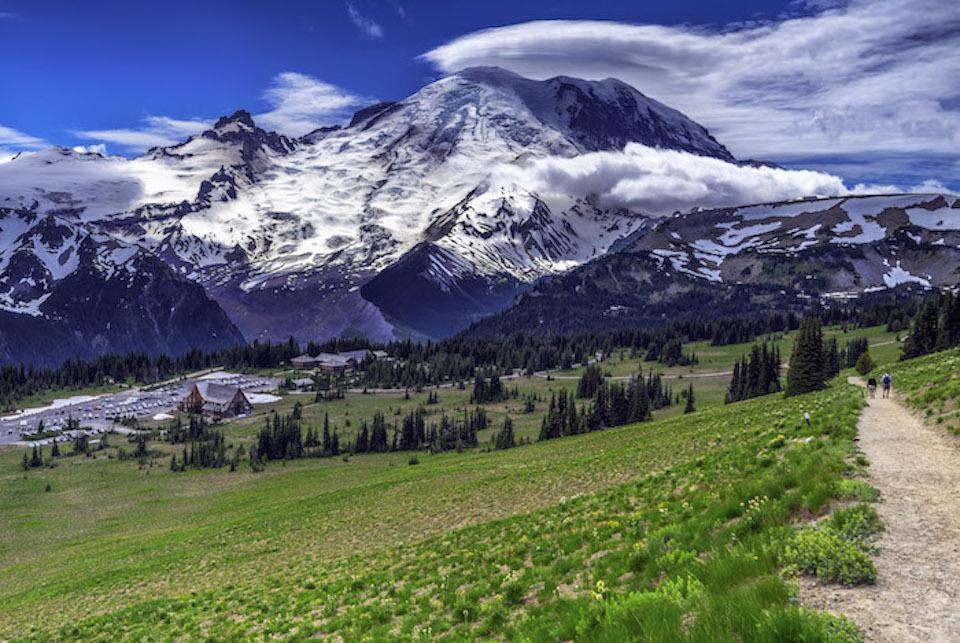
The value of nature on human existence is not lost on younger generations/Rebecca Latson
Editor's note: The following column was written by Sophie Weich, a freshman at the University of Pennsylvania.
It’s seemingly impossible to stand beneath a redwood tree without experiencing a strong emotional response. Be it their enormous size or apparent invincibility, there is something about redwoods that has the power to stop people in their tracks. In the words of author Richard Preston, when you look at a redwood tree “...You're in an undiscovered, unexplored ecosystem, somewhere between Heaven and Earth, filled with forms of life, not all of which have been given names by scientists yet.”
These magnificent trees are a prime example of the effect nature has on human beings, the power it contains to render us speechless. Whether it’s California redwoods or the majesty of the Rocky Mountains or the huge expanse of the Great Plains, we seem to be drawn to the natural world in very primal ways.
But despite our strong connection to nature, we live in a world where 55 percent of the population resides in urban areas. And according to the United Nations, that number is slated to grow to 68 percent by 2050. This level of separation from nature is unprecedented in human history, and its effects on our mental and physical health are just beginning to be observed.
Knowledge about the importance of work spaces with windows and access to nature is helping to offset some of the constant stimulation of these urban centers. Nevertheless, these small interactions cannot compare to an experience in a natural environment.

Sophie Weich is a freshman at the University of Pennsylvania/Courtesy
As an urbanized society we spend an average of 93 percent of our time indoors, leading to an epidemic of diseases such as diabetes, asthma, and obesity. For the first time in human history, more people are experiencing overnutrition than undernutrition and it is estimated that up to 75 percent of deaths worldwide are due to non-communicable diseases brought on by an unbalanced diet and a sedentary lifestyle.
And beyond physical maladies, people who live in urban areas often suffer from mental exhaustion due to the overstimulation caused by cities. According to the World Health Organization, mental health disorders constitute 10% of illness worldwide and the problem will only worsen as urbanization continues.
With this continuation of urbanization, cities will need to be expanded. A recent study done by the USDA Forest Service found that tree cover in urban areas is being reduced at rates of 36 million trees per year, primarily due to urban development. This makes interactions with the natural world even harder for city dwellers.
Luckily, studies show that busing people from a city to a park has notable physical health benefits such as improving blood pressure levels and lowering the risk of heart attacks. It also allows people to detach from their normal, stressful lives and has been proven to reduce feelings of depression and anxiety.
In the 21st century there is little, if any, land untouched by human activity but we do have prescribed areas filled with nature at our fingertips. Our national park system contains 60 official parks and over 400 national park sites in the continental United States, Alaska, Hawaii, Puerto Rico, the Virgin Islands, American Samoa, and Guam. In fact, every single state in the union contains either an official park or a park site. These incredible areas were formed with the dual purpose of protecting the ecosystems that exist within them and allowing humans to enjoy the beauty of nature. We should be taking advantage of this opportunity.
As anyone who has spent time in a national park can tell you, there is nothing quite like the feeling of coexisting with nature, even if it’s just for a few hours. It is obvious that humans are dependent on nature for physical needs such as food, water, and shelter, but we are just as reliant on it for emotional and psychological needs. Visiting national parks is the key to continuing our relationship with the natural world as urbanization continues to progress.
Sophie Weich is a DC native, currently living in Philadelphia and studying at the University of Pennsylvania. Her love of national parks began with a trip to Yellowstone when she was 7 years old and has only grown from there. She is an avid hiker and camper, and despite her East Coast connections, enjoys spending time in Northern California with her extended family. When not at school or out in the woods, she likes to play ultimate frisbee and read books about psychology.



Comments
Dear Sophie:
I'm glad you're writing about the importance of national park units.
But you shouldn't just call out urban dwellers. Do you think that rural dwellers go to national parks at a greater rate?
Not in my experience, though I don't have the numbers. They like to stay on "their land" and maybe fish or hunt in a national forest close by.
Because I don't have any land of my own and now live in a condo, I have more time to devote to hiking and understanding national parks.
Best
Danny Bernstein
www.hikertohiker.com
Good to see a new nature writer on the horizon! Thanks for the great piece! Makes me treasure our national park system (and worry about urbanization and its deleterious effects).
I somewhat respectfully disagree with the premise. Nature is all around - even in our urban settings. I mean - there are squirrels in Central Park and even coyotes in San Francisco. I live in the suburbs where I'm constantly coming across deer and I wake up to sounds of wild turkeys.
While our signature national parks are spectacular, often places closer to home are left ignored. I live a few miles away from excellent local and state parks where I can get in touch with nature.
Thanks Sophie,
The Japanese have a concept of "forest bathing."
https://www.npr.org/sections/health-shots/2017/07/17/536676954/forest-ba...
and
https://www.npr.org/sections/13.7/2018/04/04/599135342/suffering-from-na...